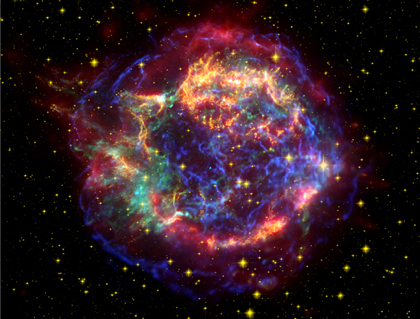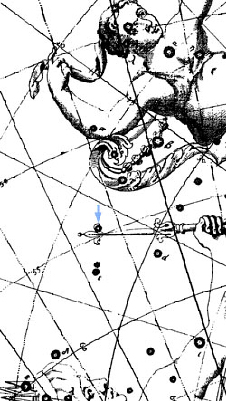King Charles II and Cassiopeia A
There is one more possible source related to the dating of the Cassiopeia A supernova event to consider that was found in the archives of the Yorkshire Museum in the UK. The following article was posted on the Sky and Telescope website after the American Astronomical Association summer meeting in Boston during May, 2011. A NASA panel and press release involving historical supernovas included the presentations of Lila Rakoczy and Dr. Gisela A. M. Dreschhoff.
Posted by Shweta Krishnan, May 27, 2011 at
Sky & Telescope

Located 10,000 light-years away, Cassiopeia A is the remnant of a once massive star that died in a violent supernova explosion seen 325 years ago. This view combines infrared observations from the Spitzer Space Telescope (colored red); visible data from the Hubble Space Telescope (yellow); and X-ray data from the Chandra X-ray Observatory (green and blue). NASA / JPL / Caltech / O. Krause
British legend has it that a bright noon star graced the birth of King Charles II on May 29, 1630. Some historians have speculated that this "star" could have been a bright comet or an unusual sighting of Venus. More recently, British astronomer Martin Lunn and American historian Lila Rakoczy suggested that people had caught a daytime glimpse of a supernova 11,000 light-years from Earth.
Cassiopeia A, discovered in 1947 by radio astronomers, is a bright, expanding cloud of gas and dust spanning roughly 10 light-years. By running its expansion rate in reverse, astronomers had estimated that the outburst from the Type IIb supernova that formed it must have reached Earth around 1667. But could the arrival date have been 37 years earlier?
Lunn and Rakoczy's case rests on the works of 17th-century poets and historians who noted the appearance of a "gleaming" and "flashing" object in the sky on the day of the royal birth. Speaking at a press briefing during the American Astronomical Society's Boston conference this week, Rakoczy said one poet had even noted, "Cassiopeia revealed a new heavenly body."
Rakoczy also dismissed the other explanations for the "noon star," arguing that the object was too bright to be Venus and that there was no astronomical evidence to suggest that a Sun-grazing comet had passed Earth in 1630.
But Charles II ruled in times when the British monarchy was struggling to hold its own against Parliament, and historians were routinely commissioned to cast the royal family in the most favorable light. So should we believe them? Rakoczy argues that these writers were accurate in noting other astronomical events, including the appearance of a comet in 1618 and a solar eclipse in 1630. She is, however, running background checks by trying to locate their personal diaries, letters, and original manuscripts.
Rakoczy and Lunn may also have a semantic concern on their hands. Their research reveals that the object had been described as "streaming hair." Given that the word comet originated from kometes, Greek for long hair, it's tempting to wonder if the object noted in 1630 was indeed an unrecorded comet.

In 1680, John Flamsteed recorded a 6th-magnitude star (arrowed) in Cassiopeia that he designated 3 Cassiopeiae and later included in his 1729 atlas. But there is no star in this location — could it have been a supernova? W. B. Ashworth Jr / JHA
Unfortunately, there's no scientific documentation of the supernova, apart from the recording of a 6th-magnitude star in Cassiopeia in 1680 by British astronomer John Flamsteed. But the coordinates for the star on his sky chart are off by almost 10°, leaving room for doubt.
Now, events high in Earth's atmosphere have perhaps scripted the story very differently, as related during the recent American Astronomical Society (AAS) meeting by physicist Gisela Dreschhoff (University of Kansas). High-energy radiation from the Cas A supernova could have ionized the atmosphere over Earth's poles, triggering the formation of nitrates that precipitated onto the polar ice. Nitrate deposits from Antarctic ice cores have been used to verify the dates of supernovae seen in 1572 and 1604. Dreschhoff also found evidence for these two supernovae in an ice core from Greenland that covers 430 years of Earth's history.
Interestingly, the Greenland ice core shows an additional nitrate spike in 1667, which Dreschhoff attributed to the Cas A supernova in a 2004 paper. But recent calls from Martin Lunn provoked Dreschhoff to search specifically for a nitrate spike in the year 1630. Unfortunately, she found none. However, speaking at the AAS conference right after Rakoczy, she cautioned, "One ice core is never enough to be absolutely certain. I would want one more." …..i.e. one more ultra-high resolution ice core…..
NOTE: Rakoczy and Lunn have been awarded a grant from the Royal Astronomical Society (RAS) to further their research for dating the Cas A event. They anticipate renewing their research at the Yorkshire Museum in June, 2012.
Back to Ice Core Index


